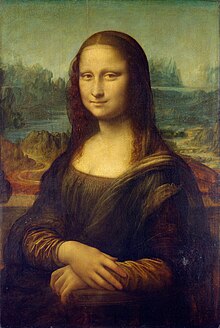User:Evebautista/Oil painting
Not to be confused with Oil paint.
"Oil on canvas" redirects here. For the album, see Oil on Canvas.
Main article: Oil painting

Oil painting is the process of painting with pigments with a medium of drying oil as the binder. Commonly used drying oils include linseed oil, poppy seed oil, walnut oil, and safflower oil. The choice of oil imparts a range of properties to the oil paint, such as the amount of yellowing or drying time. The paint could be thinned with Turpentine. Certain differences, depending on the oil, are also visible in the sheen of the paints. An artist might use several different oils in the same painting depending on specific pigments and effects desired. The paints themselves also develop a particular consistency depending on the medium. The oil may be boiled with a resin, such as pine resin or frankincense, to create a varnish prized for its body and gloss. The paint itself can be molded into different textures from the plasticity that it contains. Before oil painting was fully discovered egg tempera was commonly used. Tempara did not have the flexibility in pigment that oil paints provided.
The oldest known oil paintings were created by Buddhist artists in Afghanistan and date back to the 7th century AD. The technique of binding pigments in oil eventually made its way to Europe by at least the 12th century. The adoption of oil paint by Europeans began with Early Netherlandish painting in Northern Europe, and by the height of the Renaissance, oil painting techniques had almost completely replaced the use of previously favored tempera paints in the majority of Europe. It was not until the 15th century until oil painting was fully accepted in the United States. A few artists who are known for their oil painting techniques are Leonardo da Vinci, Pablo Picasso, Sandro Botticelli, etc. These artists use various painting techniques to achieve a desired pigment and texture.
Techniques

Traditional oil painting techniques often begin with the artist sketching the subject onto the canvas with charcoal or thinned paint. Oil paint is usually mixed with linseed oil, artist grade mineral spirits, or other solvents to make the paint thinner, faster or slower-drying. (Because the solvents thin the oil in the paint, they can also be used to clean paint brushes.) A basic rule of oil paint application is 'fat over lean', meaning that each additional layer of paint should contain more oil than the layer below to allow proper drying. If each additional layer contains less oil, the final painting will crack and peel. The consistency on the canvas depend on the layering of the oil paint. This rule does not ensure permanence; it is the quality and type of oil that leads to a strong and stable paint film.
There are other media that can be used with the oil, including cold wax, resins, and varnishes. These additional media can aid the painter in adjusting the translucency of the paint, the sheen of the paint, the density or 'body' of the paint, and the ability of the paint to hold or conceal the brushstroke. These aspects of the paint are closely related to the expressive capacity of oil paint.
Traditionally, paint was most often transferred to the painting surface using paintbrushes, but there are other methods, including using palette knives and rags. Palette knives can scrape off any paint from a canvas, it can also be used for application. Oil paint remains wet longer than many other types of artists' materials, enabling the artist to change the color, texture or form of the figure. At times, the painter might even remove an entire layer of paint and begin anew. This can be done with a rag and some turpentine for a time while the paint is wet, but after a while the hardened layer must be scraped off. Oil paint dries by oxidation, not evaporation, and is usually dry to the touch within a span of two weeks (some colors dry within days).
| This is the sandbox page where you will draft your initial Wikipedia contribution.
If you're starting a new article, you can develop it here until it's ready to go live. If you're working on improvements to an existing article, copy only one section at a time of the article to this sandbox to work on, and be sure to use an edit summary linking to the article you copied from. Do not copy over the entire article. You can find additional instructions here. Remember to save your work regularly using the "Publish page" button. (It just means 'save'; it will still be in the sandbox.) You can add bold formatting to your additions to differentiate them from existing content. |
